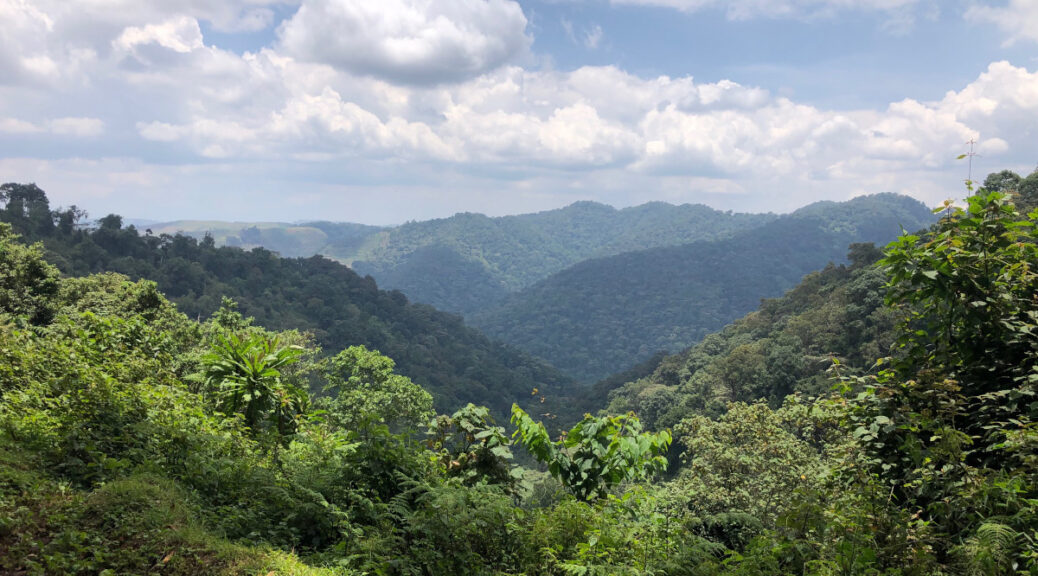No visit to Uganda can be complete without experiencing the gorillas. But Bwindi Impenetrable Forest has so much more to offer, says Sam Pinnell.
Our approach to the gate of Bwindi Impenetrable Forest is an eye-opener. It’s horrifying to see the dead straight line where the protected forest begins and where humankind stops its encroachment. As we arrive at Buhoma Lodge, on the western edge of the park, there is a massive electrical thunderstorm. But nothing can dampen our increasing excitement: tomorrow is G-Day!
A date with gorillas
At 7am, bearing gaiters, walking sticks, rain jackets, water and packed lunch, we head off to Bwindi Park HQ. The morning starts with local dancers, a health and safety briefing, and an introduction to our porters. A porter is not compulsory, but the money goes straight to the person and is a direct way of supporting the local community. And as we found out, they are worth every cent they earn. We are allocated to groups, easy, medium or difficult, which essentially means the distances the gorillas are from the start. Admin completed, kitted up, it’s time to go…

The forest is beautiful in the dappled light and the first part of our walk is along an easy path. Yonah, our ranger, points out the trees that the gorillas like with their various fruit and seeds. A little further, we turn off the path to follow a fresh gorilla track. It’s literally a track through the undergrowth. Soon we are jumping streams, slip-sliding down the muddy bank and climbing up the other side. Our sticks are invaluable, as is Isaiah, our porter, who grips my hand firmly so I don’t lose my footing.
About an hour and a half from HQ, we stop. Yonah says the gorillas are in the next clearing. He gives us final instructions, we follow him around the bush, and there they are! We watch for the next hour as the troop members climb trees, forage, descend, walk past us, sleep and play.

Also read: Gorilla trekking in Uganda – Johann Groenewald details what to expect and weighs up the choice between Uganda and Rwanda
Leader of the pack
Right near the end, the second silverback approaches and poses for us. He lies down about a metre from where we stand. The rest of our group move off to view another gorilla, but we stay. Suddenly the silverback rolls over and looks me straight in the eye. His eyes are gentle and curious, and he looks deep inside me as if to ask, “Why are you here?” I can see exactly why the females love him. He is gorgeous. We choose to spend our final five minutes alone with him.

Every report you read or hear about the gorillas tells you that it is amazing. But there really are no words adequate to describe that time: emotional, soul-filling, and incredibly, unbelievably special.
An inspiring community
Later in the afternoon, we drive to the Ride4aWoman project. We meet Evelyn, who started the project in 2009 to provide employment to the women in her community. Over 300 ladies from 11 villages now work at or with the centre. They rent out mountain bikes to visitors, run a coffee shop and restaurant, and offer 10 furnished rooms to rent. The woven baskets and quilted items are exquisite. My only sadness that we have such limited space so can’t buy too much. It’s an inspiring project, more so because the vision and start-up came from someone within this community. Ride4aWoman is definitely worth visiting.

Birding in the forest
A new day in Buhoma and a day for birding. The lodge has put us in contact with Apophia, one of the community bird guides. It’s a clear morning as we set out and our bird list grows. Buhoma is a birding hotspot, and a day with a knowledgeable guide is highly recommended.

Today we transit through the park to the Ruhija sector on the eastern edge. It’s the most scenic drive up and down the volcanic hills. At 2,340m, Ruhija catches us by surprise and our winter woollies have to make a sudden appearance! We spend the night at Broadbill Forest Camp. Our safari tent has an uninterrupted view over the forest. A three-course dinner to the sounds of the local musician at this community lodge is very good value at $10pp.
Amos is our bird guide the next morning. In our 1km walk outwards, Amos finds 15 new species of birds for us, with fantastic sightings of five endemics. There is also much evidence of the forest elephants. Although we don’t see any, it’s such a warming thought to know that we are in their presence. On the way back, Amos points out a magnificent three-horned chameleon. It’s a spectacular drive out of Ruhija as we descend the mountains. It’s been a truly special time in Bwindi and we will definitely come back here another day.
Good to know
Gorilla trekking
The best times to visit the gorillas are from June to September and in December. There is less rain, so the going is easier underfoot. Note that permits can sell out quickly during this period. The low season of January to February has few crowds and little rain.
A permit costs US$700 and gives the visitor an hour with the gorillas. It includes park entrance and ranger fees.
Where to stay
Accommodation is mostly of the lodge variety, but there is camping at the Buhoma Community Rest Camp, on the edge of the forest. Broadbill Camp is also in the process of building a campsite. These options will make Bwindi a more affordable option for many South African overlanders.


Am happy for sharing your experience in Uganda .and happy to market Uganda as the country because most people have no idea what takes place in different countries and places.